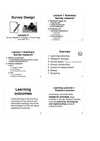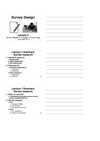Survey research and design in psychology/Lectures/Survey design
< Survey research and design in psychology < Lectures| |
This page is complete for 2016. |
Lecture 02: Survey design
| |
Resource type: this resource contains a lecture or lecture notes. |
This is the second lecture for the Survey research and design in psychology unit of study.

Outline
This lecture discusses the nuts and bolts of good survey design for research in the social sciences, including
- Research process
- Types of surveys
- Strengths and weaknesses of survey administration methods
- Survey design
- Levels of measurement
- Sampling
- Biases
- Non-sampling
- Threats to internal validity e.g., Demand characteristics
- Sampling
- Non-sampling
The lecture resources include presentation slides, audio and video recordings, and additional notes.
Readings
As per Lecture 01 readings.
Slides
- Lecture slides (Slideshare)
- 2016 handouts:
- Download 6 slides to a page:

- Download 3 slides to a page:

- Download 6 slides to a page:
Video
 from Yes Minister about how to get the poll results you want. |
See also
- Survey research (Previous lecture)
- Descriptives & graphing (Next lecture)
- Level of measurement
- Survey design
- Sampling (statistics) - Example: Shere Hite - ‘American Sexology’
This article is issued from Wikiversity - version of the Monday, February 22, 2016. The text is available under the Creative Commons Attribution/Share Alike but additional terms may apply for the media files.